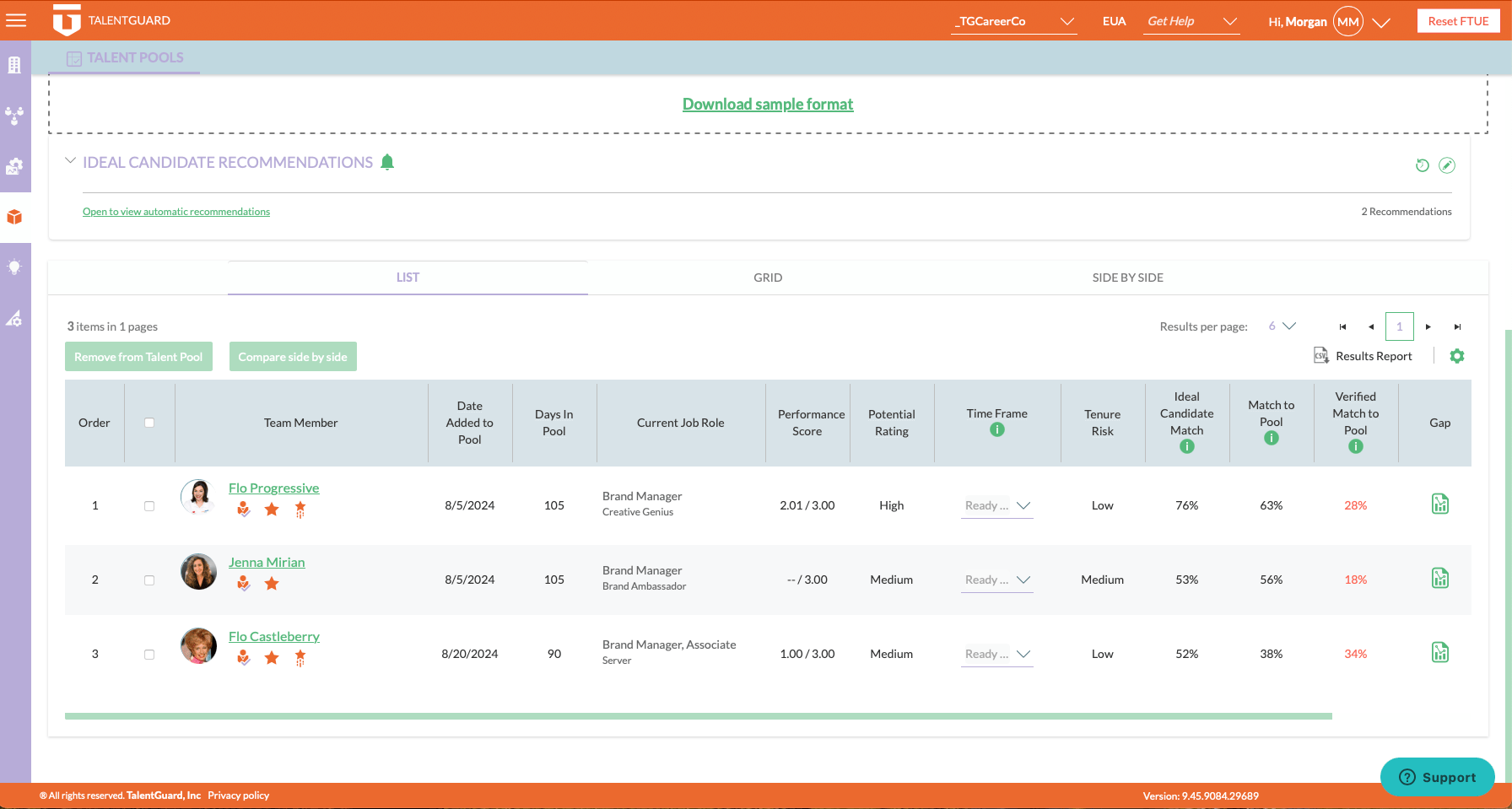How Skills-Based Succession Planning Eliminates Leadership Bias
And Cuts Transition Time by 45%

Most HR leaders will tell you succession planning is critical—but it rarely works when you actually need it.
Succession planning is one of HR‘s most talked-about processes, yet it consistently fails to deliver meaningful results. Despite annual planning sessions and carefully constructed organizational charts, most succession plans sit unused when leadership transitions occur, highlighting the need for a better approach, like skills-based succession planning, which eliminates bias and improves outcomes.
The root problem runs deeper than poor execution. Conventional succession planning often depends on seniority, influence, and subjective judgment instead of tangible evidence of capability. Although it’s labeled strategic, it frequently sustains bias beneath the surface.
So, how can HR leaders build succession plans that actually work?
At TalentGuard, we’ve seen organizations transform their leadership pipelines using skills-based succession planning. Below is our framework for eliminating bias and building evidence-based succession strategies—along with three steps you can implement today.
Why Traditional Succession Planning Falls Short
Current succession planning practices suffer from fundamental design flaws that undermine their effectiveness. Research shows that 65% of companies lack confidence in their succession planning processes, with many treating them as compliance exercises rather than strategic initiatives.
Static and Outdated Systems
Most organizations conduct succession planning annually using spreadsheets or basic HRIS systems. These static snapshots quickly become obsolete as employees develop new skills, change roles, or leave the organization. When leadership needs arise, the data driving succession decisions is often months or years outdated.
Tenure Over Talent
Traditional models prioritize time in the role and organizational hierarchy over actual capabilities. The method tends to reward longevity over proven skill, which causes many capable employees—especially those with fast-growing or diverse backgrounds—to be passed over. The outcome is a leadership bench that lacks depth and diversity.
Hidden Bias Amplification
Perhaps most problematically, traditional succession planning can reinforce unconscious biases. Age bias becomes particularly pronounced when succession planning focuses on “grooming” younger employees while overlooking mid-career professionals who may be equally or more qualified. Similarly, favoritism and networking advantages often influence succession decisions more than objective capability assessments.
Lack of Meaningful Follow-Through
Many employees view succession planning as a “tick-box” exercise with little impact on their careers. When succession plans lack concrete development pathways and regular updates, they become hollow promises that erode trust in organizational leadership development.
Why Skills-Based Succession Changes Everything
Skills intelligence replaces guesswork in succession planning with a data-backed approach that drives strategy. Instead of focusing on who to promote, it shifts the question to: What capabilities are required—and who’s already proven they have them?
This fundamental shift enables organizations to identify potential leaders based on verified competencies rather than assumptions. Skills intelligence platforms can analyze performance data, learning completion, project outcomes, and peer feedback to create objective capability profiles for every employee.
Dynamic Capability Mapping
Skills-based succession planning operates continuously rather than annually. As employees complete training, take on new responsibilities, or demonstrate new competencies, their succession readiness updates in real-time. This dynamic approach ensures that succession plans remain current and actionable during leadership transitions.
Bias Reduction Through Evidence
Organizations can significantly reduce bias in succession decisions by focusing on demonstrated skills rather than subjective impressions. Skills data provides objective evidence of capability, making it harder for unconscious preferences to influence critical personnel decisions.
Broader Talent Pool Identification
Traditional succession planning often focuses on obvious high-performers in senior roles. Skills-based approaches can identify potential leaders at every organizational level, including individual contributors who have developed strong leadership competencies through cross-functional projects or volunteer initiatives.
Skills-Based Succession in Practice
One Fortune 500 technology company reimagined succession planning through the lens of skills intelligence. Moving beyond static replacement charts, they rolled out a readiness assessment model rooted in actual skills and performance.
The transformation began with a comprehensive skills audit mapping critical competencies for each leadership role. Rather than relying solely on job descriptions, they analyzed the skills that drove success in each position, including technical capabilities and leadership competencies.
The results were striking. Their skills-based analysis identified 40% more succession-ready candidates than traditional assessments, with many coming from unexpected areas of the organization. A software engineer emerged as a strong candidate for engineering management based on demonstrated project leadership and mentoring skills. Similarly, a customer success manager showed readiness for product leadership through market analysis capabilities and customer insight generation.
Within 18 months, the organization reduced time-to-fill for leadership positions by 45% while improving new leader performance ratings by 30%. Most importantly, employee confidence in succession planning increased dramatically as individuals gained visibility into their development needs and advancement opportunities.
Reframing the Succession Question
Instead of asking, “Who do we slot in if X leaves?” the skills-based approach asks, “What skills would we lose if X left, and who already has them?” This reframing enables more strategic succession planning that considers role evolution and future skill needs rather than simple position replacement.
The approach also enables scenario-based succession planning. Organizations can model different future states and identify skill requirements for each scenario, building adaptive succession pipelines that remain relevant regardless of how business needs change.
Three Steps HR Leaders Can Take Today
HR leaders can immediately begin transforming their succession planning by taking several concrete steps. The transition doesn’t require wholesale system replacement but rather a shift in methodology and focus.
1. Audit Your Current Approach
Identify the skills that consistently lead to success in your most critical roles. Step past the surface-level descriptions and evaluate hands-on work, team insights, and measurable outcomes to pinpoint what sets top leaders apart.
2. Leverage Multiple Data Sources
Don’t depend solely on self-assessments—they’re prone to bias and rarely reflect the whole picture. A more robust capability profile draws from multiple sources: confirmed learning achievements, peer feedback, project-based leadership, and quantifiable performance results.
3. Build Readiness Layers, Not Replacement Charts
Instead of identifying single successors for each role, create readiness layers based on skill development progress. This approach recognizes that succession readiness exists on a spectrum and enables more flexible succession decisions when leadership transitions occur.
Focus on skill development pathways that transform succession planning from a selection process into a development process. Use skills gap analysis to create personalized development plans that prepare multiple candidates for leadership roles. This approach increases bench strength while demonstrating genuine investment in employee growth.
When you have multiple people developing leadership skills simultaneously, you’re not scrambling when someone unexpectedly leaves. You have options.
Why This Matters More Than Ever
Companies still using old-school succession planning are setting themselves up for trouble. Markets shift faster now, and customer expectations change overnight. The leadership skills that worked five years ago might not cut it today.
Promoting someone just because they’ve been around the longest? That’s becoming a dangerous gamble.
Here’s what works better: Focus on what people can do, not their resume or how long they’ve been in their current role. You’ll find future leaders in unexpected places—that project manager who keeps everything running smoothly or the analyst everyone turns to for answers.
And here’s the thing – good things happen everywhere else when you get succession planning right. Skills-based approaches increase employee engagement by providing clearer development pathways and reducing perceptions of favoritism. They also strengthen organizational agility by building leadership capabilities across the workforce.
Companies that make this shift will build the leadership pipeline needed to navigate future challenges. Those who don’t risk losing their best talent to organizations that better recognize and develop capability.
The transformation starts with accepting that succession planning needs fundamental reform. It’s not about discarding the concept but rebuilding it on evidence rather than assumptions.
Your next succession decision will reveal which approach your organization really takes. Make sure it identifies and develops the leaders you need.
Discover how TalentGuard’s skills intelligence platform helps you build bias-free succession plans that actually work—while improving retention, internal mobility, and leadership readiness.
Request a personalized demo today and see how your organization can transform succession planning with skills-based strategies that identify and develop real leadership capability.
See a preview of TalentGuard’s platform
Talent Pool Management – 8 Proven Tactics for Success
Effective talent pool management is key to building a strong hiring pipeline. Explore proven tactics to manage your talent pool and future-proof your hiring process. Attracting and retaining top talent has become tougher than ever. According to a study by SHRM, 77% of HR professionals have admitted that they are struggling to find job candidates […]
Best Talent Pipeline Development Software for 2025
Want to improve talent pipeline development at your company? Explore the best talent pipeline software to simplify employee management and build strong leadership pipelines. Filling leadership roles has always been a challenging task. This is especially true if the resignation is unexpected or the required skills are in short supply in the market. In such […]
10 Best Role Readiness Planning Software for 2025
Want to improve role readiness planning at your company? Explore the best role readiness planning software to simplify employee management and build a strong leadership bench. Filling leadership roles has always been a challenging task. This is especially true if the resignation is unexpected or the required skills are in short supply in the market. […]



